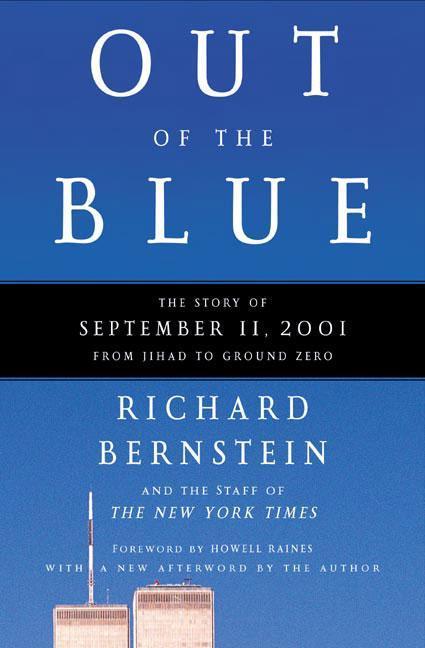Out Of The Blue : The Story Of September 11, 2001, From Jihad To Ground Zero by Richard Bernstein

View book: Out Of The Blue : The Story Of September 11, 2001, From Jihad To Ground Zero
Richard Bernstein’s Out of the Blue is a gripping and authoritative depiction of the September 11, 2001 attack, its historical origins, and its consequences. The terrorist attacks on the World Trade Center and the Pentagon were widely covered in the news, but the New York Times stood out for its comprehensive and thoughtful reporting.
With unparalleled dedication, the Times assigned one of its most talented journalists, Richard Bernstein, to transform their exceptional reporting into a captivating narrative. Bernstein takes us into the lives of heroes, victims, and terrorists, weaving a complex story of intersecting lives on that fateful morning.
We gain insight into the Al Qaeda organization and the journey of the terrorists, from their radical indoctrination to the chilling moments aboard the aircraft as they hurtled towards their dreadful fate. We also encounter the police officers, firefighters, and Trade Center workers who were lost that day, immersing ourselves in their experiences.
Furthermore, Bernstein delves into the lives of everyday Americans and national leaders in the hours and days following the attack. He meticulously chronicles the nation’s astonishing response in the aftermath.
Out of the Blue is an exceptional account of this significant moment in American history. It is a compelling, accessible, and authoritative source that unveils the full breadth of the events of September 11th.
How 9/11 conspiracy theories fuel division, distrust, and denial in society
Two and a half decades have passed since the devastating events of September 11, 2001. The memories of that fateful day are still vivid for many, etched into their minds like an indelible mark. The images of firefighters, police officers, and FBI agents gathered at Ground Zero, the Twin Towers reduced to rubble, and the chaos and debris raining down on those below continue to haunt us.
As a seasoned trial lawyer with a keen eye for evidence, skepticism was ingrained in my professional DNA. So when a student of mine, brimming with excitement, shared a video called “Loose Change,” claiming to reveal the truth behind 9/11, I couldn’t help but be intrigued. My curiosity pushed me to delve into their claims, to separate fact from fiction, and understand why these conspiracy theories gained traction and still persist.
A World Shaken by Fear
The findings of my research, conducted in collaboration with Raju Parakal, my colleague and friend, shed light on the power of fear in shaping narratives. Two prominent conspiracy theories emerged regarding the 9/11 attacks: LIHAB (President Bush Let It Happen on Purpose) and MIHOP (Made It Happen on Purpose).
It is essential to acknowledge that conspiracy theories often target the “other,” the supposed villains behind the catastrophic events. In the case of 9/11, Osama bin Laden became the embodiment of evil, the figure blamed for the unthinkable tragedy. However, it is crucial to question the motivations and influences that led to such conclusions.
The Comfort of Conspiracy
Cognitive dissonance theory, as proposed by Leon Festinger, offers valuable insights into our inclination to seek out and believe in conspiracy theories. It suggests that confronting contradictory beliefs can induce significant stress, amplifying the desire to reform narratives to alleviate discomfort.
Conspiracy theories offer an alternative reality, rewriting facts to fit preconceived notions, ease anxieties, or serve personal agendas. They provide solace and a sense of control in a world that seems chaotic and unpredictable. The events at Sandy Hook, labeled a “synthetic” and “completely fake” by some conspiracy theorists, exemplify this behavior.
A Crisis of Trust
The aftermath of 9/11 revealed a profound loss of trust in institutions, from the presidency to the government and the military. The failure to prevent such a catastrophic event shattered the perception of security, leaving individuals feeling helpless and disillusioned. The resulting skepticism gave rise to theories that questioned the very foundations of our societal structure, offering alternative explanations outside the established system.
This loss of trust, combined with the increasing polarization along partisan lines, has set the stage for the current climate of science denial. The erosion of a shared understanding of reality poses severe threats to national security, as it feeds into the discord and divisiveness that plague our nation.
Denying Reality, Confronting Truth
The events unfolding in recent years, particularly the challenges to the legitimacy of the 2020 election, underscore the dangerous consequences of denying reality. Divisions rooted in the rejection of objective facts can have far-reaching implications, eroding the foundations of our democracy and perpetuating an atmosphere of mistrust and violence.
Now more than ever, it is crucial to equip the next generation with critical thinking skills. Teaching students how to evaluate evidence and engage in rigorous research allows them to become ambassadors of truth in a world saturated with misinformation and conspiracy theories. By doing so, we can hope to counter the corrosive effects of denialism and work towards a society guided by reason, evidence, and unity.
Fear may continue to grip us, but by arming ourselves with the tools of reason and knowledge, we can emerge stronger, more resilient, and better equipped to confront the challenges that lie ahead.







Leave a Reply